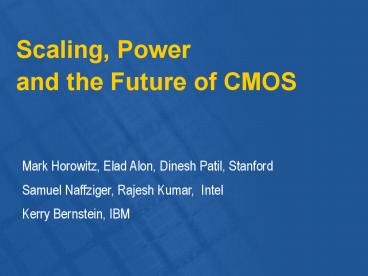Scaling, Power and the Future of CMOS - PowerPoint PPT Presentation
1 / 18
Title:
Scaling, Power and the Future of CMOS
Description:
Exploit Parallelism / Scale Vdd. If you have parallelism. Add more function units ... by application-level optimization, parallelism/specialized functional units, and ... – PowerPoint PPT presentation
Number of Views:89
Avg rating:3.0/5.0
Title: Scaling, Power and the Future of CMOS
1
Scaling, Powerand the Future of CMOS
Mark Horowitz, Elad Alon, Dinesh Patil,
Stanford Samuel Naffziger, Rajesh Kumar,
Intel Kerry Bernstein, IBM
2
An Old Problem
- Until mid 80s technology was mixed
- nMOS, bipolar, some CMOS
- Supply voltage was not scaling / power was rising
- nMOS, bipolar gates dissipate static power
From Roger Schmidt, IBM Corp
3
Solution Move to CMOS
- And then scale Vdd
4
Bad News
- Voltage scaling has stopped as well
- kT/q does not scale
- Vth scaling has power consequences
- If Vdd does not scale
- Energy scales slowly
Ed Nowak, IBM
5
Energy Performance Space
- Every design is a point on a 2-D plane
6
Energy Performance Space
- Every design is a point on a 2-D plane
7
Energy Performance Space
- Every design is a point on a 2-D plane
8
Trade-offs for an Adder
9
Key Observation
- Define the Energy/Delay sensitivity of parameter
- For example Vdd
- At optimal point, all sensitivities should be the
same - Must equal the slope of the Pareto optimal curve
10
What This Means
- Vdd and Vth are not directly set by scaling
- Instead set by slope of Pareto optimal curve
- Leakage rose to lower total system power!
11
Cost of Variation
- Variability changes position of the optimal
curves - Need to margin Vth, Vdd to ensure circuit always
works
12
Partial Compensation
- Adjust Vdd after you get part back
- Compensates very well for small deviations in Vth
D Vth 120 mV
D Vth 0 mV
13
Variable Application Demands
- Try to provide a couple of operating points
- Application can control speed and energy
- Hard question is what are valid Vdd, F pairs
- Usually determined during test
- Dynamic voltage scaling
- Intel Speed Step in laptop processors
- 2 performance/power points
- Transmeta Long Run Technology
- Many operating points. Test data formula
14
Self Checking Hardware
- Razor (Austin/Blaauw, U of Mich)
- Use the actual hardware to check for errors
- Latch the input data twice
- Once on the clock edge, and then a little later
- If the data is not the same, you are going too
fast
15
Future Systems
- Some simple math
- Assume scaling continues
- Dies dont shrink in size
- Average power/gate must decrease by 2x /
generation - Since gates are shrinking in size
- Get 1.4x from capacitive reduction
- Where is the other factor of 1.4x ?
16
Exploit Parallelism / Scale Vdd
- If you have parallelism
- Add more function units
- Fill up new die (2x)
- Lower energy/op
- DE/DP will decrease
- Vdd, sizes, etc will reduce
- Build simpler architectures
- Works well when DE/DP is large
- Per unit performance decrease is small
17
Exploit Specialization
- Optimize execution units for different
applications - Reformulate the hardware to reduce needed work
- Can improve energy efficiency for a class of
applications - Stream / Vector processing is a current example
- Exploit locality, reuse
- High compute density
HISC
NI
µ-controller
SRF
Clusters
Memory System
Bill Dally et al, Stanford Imagine
18
Conclusions
- Unfortunately power is an old problem
- Magic bullets have mostly been spent
- Power will be addressed by application-level
optimization, parallelism/specialized functional
units, and more adaptive control - Need to rethink scaling
- Still makes things cheaper
- But what do we want from scaled transistors?































